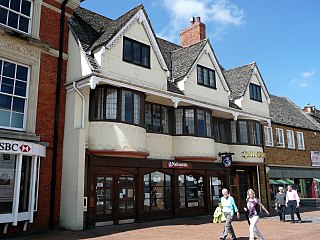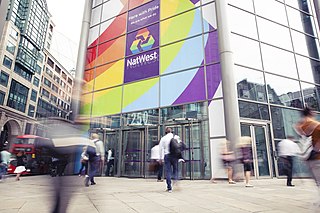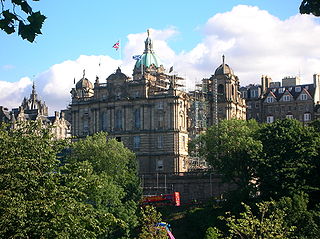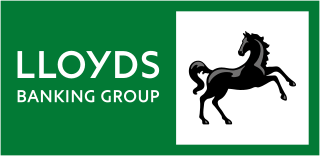
A building society is a financial institution owned by its members as a mutual organization, which offers banking and related financial services, especially savings and mortgage lending. They exist in the United Kingdom, Australia and New Zealand, and formerly in Ireland and several Commonwealth countries, including South Africa as mutual banks. They are similar to credit unions, but rather than promoting thrift and offering unsecured and business loans, the purpose of a building society is to provide home mortgages to members. Borrowers and depositors are society members, setting policy and appointing directors on a one-member, one-vote basis. Building societies often provide other retail banking services, such as current accounts, credit cards and personal loans. The term "building society" first arose in the 19th century in Great Britain from cooperative savings groups.

The Bank of Scotland plc is a commercial and clearing bank based in Edinburgh, Scotland, and is part of the Lloyds Banking Group. The bank was established by the Parliament of Scotland in 1695 to develop Scotland's trade with other countries, and aimed to create a stable banking system in the Kingdom of Scotland.
The Abbey National Building Society was formed in 1944 by the merger of the Abbey Road and the National building societies.

Yorkshire Bank is a trading name used by Clydesdale Bank plc for its retail banking operations in England.

Lloyds Bank plc is a British retail and commercial bank with branches across England and Wales. It has traditionally been considered one of the "Big Four" clearing banks. Lloyds Bank is the largest retail bank in Britain, and has an extensive network of branches and ATMs in England and Wales and offers 24-hour telephone and online banking services.

Alliance & Leicester plc was a British bank and former building society, formed by the merger in 1985 of the Alliance Building Society and the Leicester Building Society. The business demutualised in the middle of 1997, when it was floated on the London Stock Exchange. It was listed in the FTSE 250 Index, and had been listed in the FTSE 100 Index from April 1997 until June 2008.

The Trustee Savings Bank (TSB) was a British financial institution that operated between 1810 and 1995 when it was merged with Lloyds Bank. Trustee savings banks originated to accept savings deposits from those with moderate means. Their shares were not traded on the stock market but, unlike mutually held building societies, depositors had no voting rights; nor did they have the power to direct the financial and managerial goals of the organisation. Directors were appointed as trustees on a voluntary basis. The first trustee savings bank was established by Rev. Henry Duncan of Ruthwell in Dumfriesshire for his poorest parishioners in 1810, with its sole purpose being to serve the local people in the community. Between 1970 and 1985, the various trustee savings banks in the United Kingdom were amalgamated into a single institution named TSB Group plc, which was floated on the London Stock Exchange. In 1995, the TSB merged with Lloyds Bank to form Lloyds TSB, at that point the largest bank in the UK by market share and the second-largest by market capitalisation.
Bank of Scotland (Ireland) Limited was a wholly owned subsidiary of the Bank of Scotland, which later became part of Lloyds Banking Group. It offered commercial and corporate banking services under the Bank of Scotland brand and retail banking services under the Halifax brand. From 10 February 2010 the bank no longer accepted new business and it ceased to operate as a licensed bank on 31 December 2010. The assets of the bank were merged into Bank of Scotland plc.
The Woolwich Equitable Building Society was founded in Woolwich in 1847 and remained a local institution until after WWI when it began a modest regional expansion. This accelerated after WWII and the period from 1960 was notable for its acquisitions. Following deregulation, the Society diversified and became one of the largest national building societies.
Bristol & West (B&W) was a former mutual building society in the United Kingdom (UK), one of the first to be demutualised to become a publicly traded bank in 1997. Bristol & West had its headquarters in Bristol, England, UK. B&W became a division of the UK arm of the Bank of Ireland in 1997.
Birmingham Midshires is an online trading name of Bank of Scotland plc. It is headquartered at Pendeford Business Park, Wolverhampton. It previously had 67 branches throughout England and Wales. Previously, Birmingham Midshires was a building society, known as the Birmingham Midshires Building Society.

The HBOS Group Reorganisation Act 2006 is a local act of Parliament, passed by the Parliament of the United Kingdom in June 2006. The aim of the act was to provide HBOS plc, a banking and insurance group in the UK, the legal authority to reorganise its subsidiaries into a simplified structure. It came into effect on 17 September 2007.
Bank of Scotland International Limited was the international banking division of Bank of Scotland. Established in 2003, it was headquartered in Jersey, and operated branches on the Isle of Man and Hong Kong, until merging with Lloyds TSB Offshore in 2011 as Lloyds TSB International brand.

National Westminster Bank, trading as NatWest, is a major retail and commercial bank in the United Kingdom based in London, England. It was established in 1968 by the merger of National Provincial Bank and Westminster Bank. In 2000, it became part of The Royal Bank of Scotland Group, which was re-named NatWest Group in 2020. Following ringfencing of the group's core domestic business, the bank became a direct subsidiary of NatWest Holdings; NatWest Markets comprises the non-ringfenced investment banking arm. The British government currently owns 35% of NatWest Group after spending £45 billion bailing out the lender in 2008; the proportion at one point was 54.7%. NatWest International is a trading name of RBS International, which also sits outside the ringfence.

HBOS plc is a banking and insurance company in the United Kingdom, a wholly owned subsidiary of the Lloyds Banking Group, having been taken over in January 2009. It was the holding company for Bank of Scotland plc, which operated the Bank of Scotland and Halifax brands in the UK, as well as HBOS Australia and HBOS Insurance & Investment Group Limited, the group's insurance division.

Lloyds Banking Group plc is a British financial institution formed through the acquisition of HBOS by Lloyds TSB in 2009. It is one of the UK's largest financial services organisations, with 30 million customers and 65,000 employees. Lloyds Bank was founded in 1765 but the wider Group's heritage extends over 320 years, dating back to the founding of the Bank of Scotland by the Parliament of Scotland in 1695.

Cheltenham & Gloucester plc (C&G) was a mortgage and savings provider in the United Kingdom, a subsidiary of Lloyds Banking Group. C&G specialised in mortgages and savings products. Previously, C&G was a building society, the Cheltenham and Gloucester Building Society. Its headquarters were in Barnwood, Gloucester, Gloucestershire, England. C&G was closed to new mortgage and savings business on 9 September 2013.

TSB Bank plc is a British retail and commercial bank based in Edinburgh, Scotland. It has been a subsidiary of Sabadell Group since 2015.
Sabadell Solbank was a Spanish bank owned by Banco de Sabadell, which focussed on retail banking for Europeans living in the coastal areas of southern Spain. In 2014, it was fully integrated into the parent company.


















